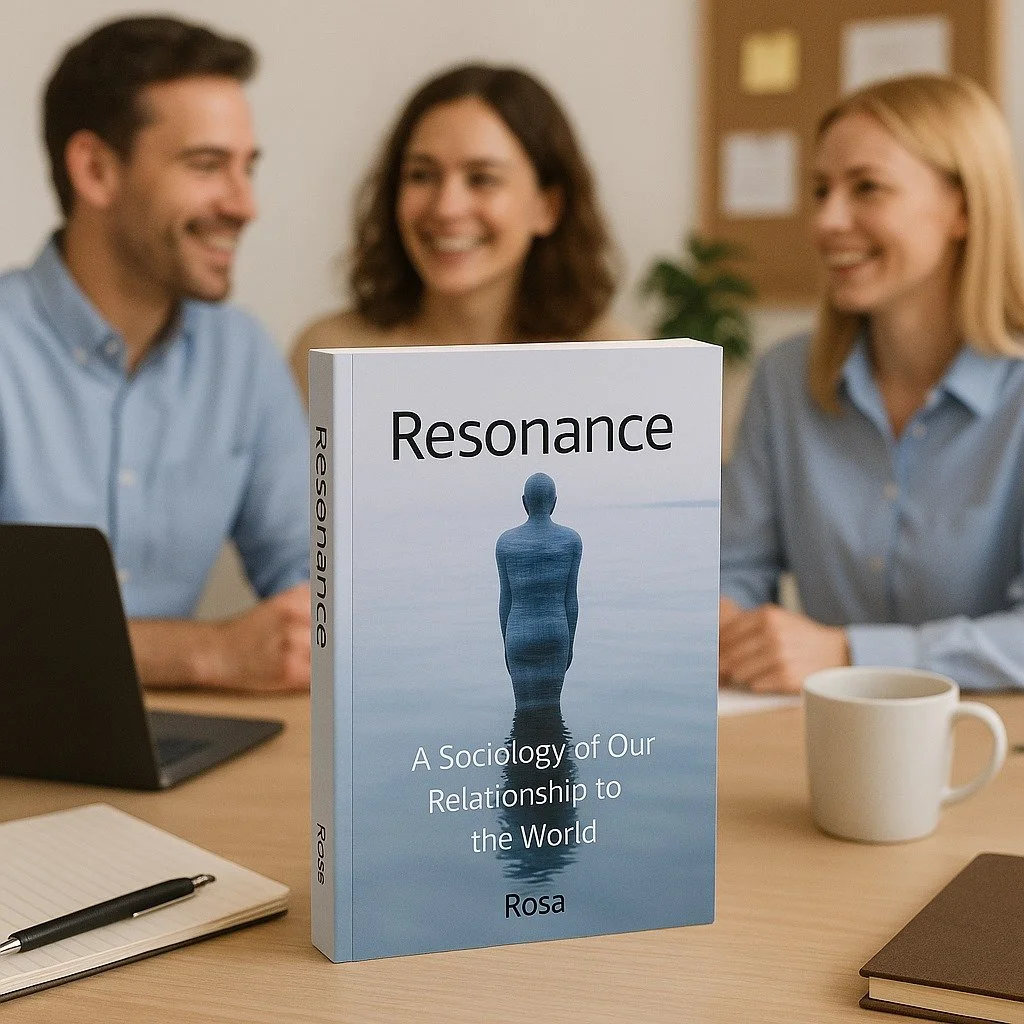Many Voices Together: The Leadership of Resonance
What Hartmut Rosa’s "Resonance” mean for leaders and organizations
This is the second post of a series of articles: The “Un-Lead Vibe”: Resonating for a Better Future
Read Part 1: The World's Silent Hum: Why We Need to Tune into Resonance - Read Part 3: The Community Studio (case study)
Read Siegfried Lautenbacher’s response to this post: The Art of Being Touched: What Individual Psychology Adds to Resonant Leadership
It's a bit ironic to write about ideal leadership in our professional life, when so many people around the world seem drawn to its degenerate, toxic avatar in our public life.
Attraction to the self-important, cruel and corrupt “great man” sticks to the human psyche like duct tape we can't get rid of, century after century.
We keep electing people like this into the highest offices, eventually repenting in view of the damage they cause, only to do it all over again a generation later or even sooner. It's pretty hopeless. But losing hope is not an option, as the philosopher Hartmut Rosa invites us to do in his book “Resonance: A Sociology of Our Relationship to the World”.
In a previous article, I tried to sum up Rosa's notion of resonance – that quality interaction with the world that moves us, shapes us and sets us free – and what stands out for me.
Today, I'd like to bring together resonance as defined by Rosa, and the practice of leadership as I see it. I believe it matters for anyone who cares about the workplace, and in particular for corporate practitioners: team leads, corporate communication officers, human resources professionals, senior executives, change professionals, and anyone exposed to or shaping the work experience of others through leadership.
Leadership is still too often thought of as a personal skill (or set of skills). I’m convinced this is wrong.
Leadership is a collective capacity that emerges from a diverse, connected, and purposeful group of people acting together to fulfill their common aspiration. That’s why I tend to name it “relational” leadership, as in Dare to Un-Lead’s subtitle.
How can this leadership create resonance?
Why should it?
What are the lessons to be learned, but also the pitfalls to be avoided, for people wishing to question their own leadership or that of others with a view to improving it?
I'll be analyzing these questions in 3 stages, moving on fairly quickly through the first: why “classic” leadership harms resonance – just skip this part if you're familiar with the observation. We'll then look at a series of false good ideas, followed by more promising practices.
1. What Mutes an Organization: The Erosion of Resonance in Modern Leadership
Traditional, often unconscious, leadership practices actively extinguish resonance. These are the patterns that contribute to the very "silent crisis of modern organizations" we discussed in the previous post, pushing individuals and the collective into a state of alienation where work no longer "speaks" to people.
This is evident in eye-watering global employee engagement rates, which remain stubbornly low at just 23% in 2024, with only 30% of managers feeling engaged (people don’t want to be managers anymore, by the way). The consequence is a soaring burnout epidemic (burnout being a state in which “all axes of resonance have become mute and deaf”, according to Rosa), costing companies billions and leaving deep social wounds.
While our extractive capitalist system and the acceleration of the world have a lot to do with it, within organizations specific phenomena suppress resonance possibilities.
Twisted Self-Efficacy, Anxiety and People Reification
First, the rigidification and automation of work processes make employees perceive (often rightly) that their agency and capacity for unique impact are being eroded.
Remember David Graeber's research on "bullshit jobs"? Now, in addition to feeling useless, workers fear being made irrelevant by AI. “Fear and anxiety are paradigmatic ‘resonance killers’, as – at least when they are overpowering – they prevent the subject from opening it up to, tuning into, or becoming involved in the world,” Rosa writes.
This pervasive sense of powerlessness at work directly contributes to fueling the populist rhetoric outside of work. It is exacerbated by poor management, where insecure or over-pressured leaders demand obedience, alignment, order, certainty, speed, and execution, instead of inviting participation.
As Rosa explains, "The error of modernity lies in the confusion of a mute, results-oriented concept of self-efficacy geared toward domination and control with the experience of a resonant, influential, process- and response-oriented form of self-efficacy".
This often leads to the "reification of the self and others". I've seen a million times how easy it is to dehumanize others in the workplace and to fall into purely transactional relationships with colleagues, team members, or managers.
Silo Segmentation and Social Atomization
Work often gets in the way of what Rosa calls "horizontal resonance" – meaningful relationships with other human beings.
Because of their size, ingrained work habits or simply a lack of imagination, organizations often favor segmentation rather than the development of dynamic internal networks. Segmentation is horizontal (by level – C-level, etc.) as well as vertical (by function – R&D, Marketing, etc.) and no amount of project team or “affinity network” (often another segmentation opportunity) can make up for it. Leaders underestimate the negative impact of inequalities (in access to information, status…) in operating modes that are still highly hierarchical.
With the "raison d'être" trend, companies have taken to proclaiming how they are "changing the world", attempting to mobilize their employees around a noble goal, but often going no further than the simple "purpose-washing" of their activity. Cultivating a true community feeling and the mutual support necessary for genuine connection remains a complicated exercise.
Leaving individuals to feel disconnected and replaceable, living an "atomized and monadic experience" at work, is extremely detrimental to the "productive polyphony" an organization might otherwise achieve.
So, what's to be done? First of all, beware of false good ideas.
2. Beware of False Resonances: Navigating Modern Workplace Illusions
Certain popular workplace trends, while seemingly positive, often fail to foster genuine resonance and can even perpetuate its erosion.
These are "false good ideas" – attempts to create connection that, in Rosa's terms, miss the mark or even become pathological "resonance killers."
Emotional Stimulation as a Substitute for Connection
One such illusion is the mere emotional stimulation of the workforce. Companies invest heavily in wellness programs, communication materials, and vibrant office aesthetics, aiming to create a positive "vibe."
Yet, as Rosa warns, "Because there is no connection that allows self-efficacy, there is always a risk that consumers [or workers addressed as consumers] will merely be emotionally stimulated rather than truly affected".
This form of "aestheticization, psychologization, and emotionalization" of the workplace […] can create a superficial appeal without true depth.
Resonance, Rosa reminds us, "is not an emotional state, but a mode of relation that is neutral with respect to emotional content".
Without genuine pathways for active influence and mutual transformation, such efforts remain "mute," failing to ignite that "energetically charged form of contact" between self and world.
Competition and the Allure of Maximization
Another widespread practice that undermines resonance is the relentless promotion of competition and the appeal to maximize individual economic or status interests. “We don’t do that here! We encourage collaboration,” I sometimes hear from clients. Yet, they maintain noxious performance management systems in place.
While appearing to drive performance, Rosa explicitly states that "competition and resonance are thus two incompatible attitudes toward the world".
When individuals are primarily motivated by "the desire to maximize economic, status related, or otherwise entirely undefined utility," their actions are distanced from the deeper "quest for resonance and the fear of alienation as modes of relation" that constitute "the fundamental drives of human behavior".
This hyper-competitive orientation fosters a dispositional alienation, transforming colleagues into rivals rather than partners in a shared, responsive endeavor.
The Perils of Full Openness and Consensus
Thirdly, the contemporary demand for full openness, transparency, and even raw authenticity in the workplace – often framed as "come as you are" or the embrace of "psychological safety" – can paradoxically hinder resonance.
While seemingly positive, this trend can lead to forced vulnerability or a performative display of emotions. It also encourages the simplification of the individual's social identity around a “single story”.
Rosa's nuanced view reminds us that "resonant relationships require that both subject and world be sufficiently 'closed' or self-consistent so as to each speak in their own voice, while also remaining open enough to be affected or reached by each other".
Also, the relentless quest for agreement, consensus, and an appeased social climate in the workplace (as seen in the silencing of unions or dissent) can lead to a pathological "echo chamber."
Yet genuine resonance thrives on the generative tension of difference and contradiction, not their suppression.
The Measurement Delusion
Finally, the pervasive quantification of everything, driven by an obsession with measurement and data, actively undermines resonance at work.
While promising efficiency and objective insight, this trend transforms qualitative relationships into measurable metrics.
As Rosa observes, "Efforts to ensure quality in particular – even and especially when they exhibit a sense for the quality of relationships [...] are often gateways to the worst manifestations of transforming resonant relationships into mute relationships".
The "bureaucratic compulsion to produce documents [...], to measure and quantify every accomplishment and even idea, makes life hell for workers [...]. It prevents them for doing their work properly and well". Hear, hear!
When everything is quantified and optimized, the inherent "inaccessibility" and spontaneous nature of true resonance are destroyed, reducing the richness of human interaction to a series of data points.
This pushes us further towards a "mute relationship to the world," seeing people only as resources to be extracted, rather than partners in a vibrant, responsive exchange.
3. Making Work Sing: Leadership for Resonance
How can leadership actively cultivate resonance in organizations?
This is not merely a soft skill or a fleeting trend; it is a social imperative and, increasingly, a critical business strategy as well.
Rosa notes that “employers have a commanding interest in this sensitivity to resonance, they require workers who are socially empathetic, equipped with a fine sense for the demands of their colleagues as well as their clients, for moods and atmospheres, and who, moreover, are capable of fully applying their creative and inspirational impulses to their work.”
He adds that “group projects and teamwork, which have become dominant in many fields in late modernity, require resonant personality structures.”
Which leadership practices help unlock this human potential?
Enabling Active Self-Efficacy
Resonant leadership creates the conditions and the possibility for individuals to experience genuine self-efficacy – the active side of their relationship to the world.
It fosters an environment where employees can truly "generate resonance." This is what I have in mind when I work on engagement projects: engagement as in “Making people want to take a lead and create”, not as in the “How satisfied are you?” type of engagement that is typically measured by companies’ engagement surveys.
The Canadian psychologist Albert Bandura, who introduced the concept of self-efficacy in 1977, is quoted by Rosa saying:
“People make causal contributions to their own functioning through mechanisms of personal agency. Among the mechanisms of agency, none is more central or pervasive than people's beliefs about their capabilities to exercise control over their own level of functioning and over events that affect their lives. Efficacy beliefs influence how people feel, think, motivate themselves and behave.”
Perceived self-efficacy multiplied by many people means a sense of collective self-efficacy that propels organizations forward.
This means creating spaces where individuals can not only contribute their unique talents but also experience the "interplay and reciprocity that emerges in the process", feeling their impact and seeing their work "speak" back to them.
It's about shifting from being managed to being truly influential – wherever people are in the organization.
Cultivating Relatedness and Shared Meaning
Resonant leadership actively counters silo segmentation and social atomization by fostering relatedness and a space where people can make sense together of what happens to them and their organization. It intentionally builds bridges that transcend hierarchical and functional divides.
This isn't about forced harmony, but about creating an environment where a "common, interpersonal space of meaning" can emerge.
Rosa emphasizes that "the capacity for mutual empathy, understanding, and adopting other perspectives is important not just for the development of socio moral qualities, but for learning, thinking, and acting in general".
Leaders facilitate this by valuing diverse perspectives and encouraging genuine engagement, allowing for the "contradiction" that Rosa sees as essential for true resonance, rather than suppressing it for a false consensus.
They cultivate a context where people are "hyper-attuned to each other emotionally" and can truly "enter into a responsive relationship" with one another.
Amplifying Voice and Weaving Stories
Perhaps most fundamentally, resonance-inducing leadership is about amplifying every voice and weaving compelling collective stories.
Rosa emphasizes that "the first and fundamental organ through which we enter into a responsive relationship with the world and make the world respond to us is the voice".
Leaders must create channels and a culture where every individual feels that s/he can speak, be heard, and truly contribute to the organization's "productive polyphony."
Beyond individual voices, it is through shared narratives that "Human beings generate strong empathetic resonances".
Leaders are therefore no longer the sole sources of stories, and no longer the sole storytellers either. They become curators and witnesses too, understanding that "Social communities are first and foremost communities of narration, possessing a common repertoire of resonance producing and resonance directing stories".
By fostering a dynamic polyphony of voices and narratives, leadership moves us closer to Rosa's "fundamental promise of modernity... the great hope of a singing world" within our organizations.
* * *
The journey to a resonant organization, where work genuinely "sings," demands a conscious shift from traditional, extractive leadership to practices that amplify agency, foster genuine relatedness, and cultivate a dynamic polyphony of voices.
In the final part of this series, I will unveil a concrete, practical application of these principles: The Community Studio, a proven approach designed to help organizations build these vital connections and bring the promise of resonance to life.


